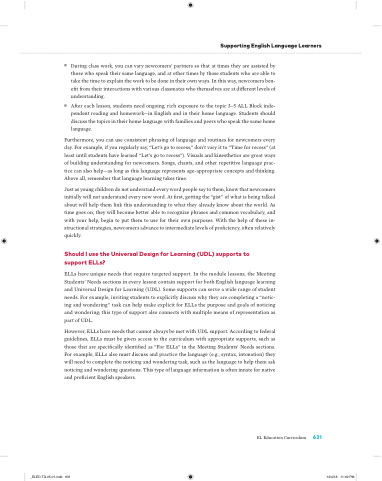Page 655 - EL Grade 5 Teacher Guide
P. 655
Supporting English Language Learners
■ During class work, you can vary newcomers’ partners so that at times they are assisted by those who speak their same language, and at other times by those students who are able to take the time to explain the work to be done in their own ways. In this way, newcomers ben- e t from their interactions with various classmates who themselves are at di erent levels of understanding.
■ After each lesson, students need ongoing, rich exposure to the topic 3–5 ALL Block inde- pendent reading and homework—in English and in their home language. Students should discuss the topics in their home language with families and peers who speak the same home language.
Furthermore, you can use consistent phrasing of language and routines for newcomers every day. For example, if you regularly say, “Let’s go to recess,” don’t vary it to “Time for recess” (at least until students have learned “Let’s go to recess”). Visuals and kinesthetics are great ways of building understanding for newcomers. Songs, chants, and other repetitive language prac- tice can also help—as long as this language represents age-appropriate concepts and thinking. Above all, remember that language learning takes time.
Just as young children do not understand every word people say to them, know that newcomers initially will not understand every new word. At rst, getting the “gist” of what is being talked about will help them link this understanding to what they already know about the world. As time goes on, they will become better able to recognize phrases and common vocabulary, and with your help, begin to put them to use for their own purposes. With the help of these in- structional strategies, newcomers advance to intermediate levels of pro ciency, often relatively quickly.
Should I use the Universal Design for Learning (UDL) supports to support ELLs?
ELLs have unique needs that require targeted support. In the module lessons, the Meeting Students’ Needs sections in every lesson contain support for both English language learning and Universal Design for Learning (UDL). Some supports can serve a wide range of student needs. For example, inviting students to explicitly discuss why they are completing a “notic- ing and wondering” task can help make explicit for ELLs the purpose and goals of noticing and wondering; this type of support also connects with multiple means of representation as part of UDL.
However, ELLs have needs that cannot always be met with UDL support. According to federal guidelines, ELLs must be given access to the curriculum with appropriate supports, such as those that are speci cally identi ed as “For ELLs” in the Meeting Students’ Needs sections. For example, ELLs also must discuss and practice the language (e.g., syntax, intonation) they will need to complete the noticing and wondering task, such as the language to help them ask noticing and wondering questions. This type of language information is often innate for native and pro cient English speakers.
EL Education Curriculum 631
_ELED.TG.05.01.indb 631
12/4/18 11:49 PM


